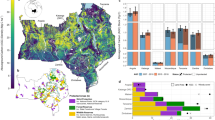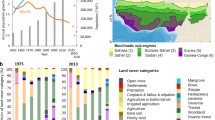Abstract
The rapidly growing human population in sub-Saharan Africa generates increasing demand for agricultural land and forest products, which presumably leads to deforestation. Conversely, a greening of African drylands has been reported, but this has been difficult to associate with changes in woody vegetation. There is thus an incomplete understanding of how woody vegetation responds to socio-economic and environmental change. Here we used a passive microwave Earth observation data set to document two different trends in land area with woody cover for 1992–2011: 36% of the land area (6,870,000 km2) had an increase in woody cover largely in drylands, and 11% had a decrease (2,150,000 km2), mostly in humid zones. Increases in woody cover were associated with low population growth, and were driven by increases in CO2 in the humid zones and by increases in precipitation in drylands, whereas decreases in woody cover were associated with high population growth. The spatially distinct pattern of these opposing trends reflects, first, the natural response of vegetation to precipitation and atmospheric CO2, and second, deforestation in humid areas, minor in size but important for ecosystem services, such as biodiversity and carbon stocks. This nuanced picture of changes in woody cover challenges widely held views of a general and ongoing reduction of the woody vegetation in Africa.
This is a preview of subscription content, access via your institution
Access options
Access Nature and 54 other Nature Portfolio journals
Get Nature+, our best-value online-access subscription
$29.99 / 30 days
cancel any time
Subscribe to this journal
Receive 12 digital issues and online access to articles
$119.00 per year
only $9.92 per issue
Buy this article
- Purchase on Springer Link
- Instant access to full article PDF
Prices may be subject to local taxes which are calculated during checkout




Similar content being viewed by others
References
Gerland, P. et al. World population stabilization unlikely this century. Science 346, 234–237 (2014).
Lambin, E. F. & Meyfroidt, P. Global land use change, economic globalization, and the looming land scarcity. Proc. Natl Acad. Sci. USA 108, 3465–3472 (2011).
Hansen, M. C. et al. High-resolution global maps of 21st-century forest cover change. Science 342, 850–853 (2013).
Mayaux, P. et al. State and evolution of the African rainforests between 1990 and 2010. Phil. Trans. R. Soc. Lond. B 368, 20120300 (2013).
Zhou, L. et al. Widespread decline of Congo rainforest greenness in the past decade. Nature 509, 86–90 (2014).
Fensholt, R. et al. Greenness in semi-arid areas across the globe 1981–2007 — an Earth Observing Satellite based analysis of trends and drivers. Remote Sens. Environ. 121, 144–158 (2012).
Andela, N., Liu, Y. Y., van Dijk, A. I. J. M., de Jeu, R. A. M. & McVicar, T. R. Global changes in dryland vegetation dynamics (1988–2008) assessed by satellite remote sensing: comparing a new passive microwave vegetation density record with reflective greenness data. Biogeosciences 10, 6657–6676 (2013).
Kaptué, A. T., Prihodko, L. & Hanan, N. P. On regreening and degradation in Sahelian watersheds. Proc. Natl Acad. Sci. USA 112, 12133–12138 (2015).
Ahlström, A. et al. The dominant role of semi-arid ecosystems in the trend and variability of the land CO2 sink. Science 348, 895–899 (2015).
Brandt, M. et al. Woody plant cover estimation in drylands from Earth Observation based seasonal metrics. Remote Sens. Environ. 172, 28–38 (2016).
Donohue, R. J., McVicar, T. R. & Roderick, M. L. Climate-related trends in Australian vegetation cover as inferred from satellite observations, 1981–2006. Glob. Change Biol. 15, 1025–1039 (2009).
Zhu, Z. et al. Greening of the Earth and its drivers. Nat. Clim. Change 6, 791–795 (2016).
Kolby Smith, W. et al. Large divergence of satellite and Earth system model estimates of global terrestrial CO2 fertilization. Nat. Clim. Change 6, 306–310 (2015).
Shimada, M. et al. New global forest/non-forest maps from ALOS PALSAR data (2007–2010). Remote Sens. Environ. 155, 13–31 (2014).
Tian, F., Brandt, M., Liu, Y. Y., Rasmussen, K. & Fensholt, R. Mapping gains and losses in woody vegetation across global tropical drylands. Glob. Change Biol. http://dx.doi.org/10.1111/gcb.13464 (2016).
van Marle, M. J. E., van der Werf, G. R., de Jeu, R. A. M. & Liu, Y. Y. Annual South American forest loss estimates based on passive microwave remote sensing (1990–2010). Biogeosciences 13, 609–624 (2016).
Jones, M. O., Kimball, J. S. & Jones, L. A. Satellite microwave detection of boreal forest recovery from the extreme 2004 wildfires in Alaska and Canada. Glob. Change Biol. 19, 3111–3122 (2013).
Brandt, M. et al. Ground- and satellite-based evidence of the biophysical mechanisms behind the greening Sahel. Glob. Change Biol. 21, 1610–1620 (2015).
Wigley, B. J., Bond, W. J. & Hoffman, M. T. Thicket expansion in a South African savanna under divergent land use: local vs. global drivers? Glob. Change Biol. 16, 964–976 (2010).
Mitchard, E. T. A. & Flintrop, C. M. Woody encroachment and forest degradation in sub-Saharan Africa’s woodlands and savannas 1982–2006. Phil. Trans. R. Soc. Lond. B 368, 20120406 (2013).
Metzger, M. J. et al. A high-resolution bioclimate map of the world: a unifying framework for global biodiversity research and monitoring. Glob. Ecol. Biogeogr. 22, 630–638 (2013).
Gherardi, L. A. & Sala, O. E. Enhanced precipitation variability decreases grass- and increases shrub-productivity. Proc. Natl Acad. Sci. USA 112, 12735–12740 (2015).
Smith, B. et al. Implications of incorporating N cycling and N limitations on primary production in an individual-based dynamic vegetation model. Biogeosciences 11, 2027–2054 (2014).
Yang, Y., Donohue, R. J., McVicar, T. R., Roderick, M. L. & Beck, H. E. Long-term CO2 fertilization increases vegetation productivity and has little effect on hydrological partitioning in tropical rainforests. J. Geophys. Res. Biogeosci. 2016, JG003475 (2016).
Bond, W. J. & Midgley, G. F. Carbon dioxide and the uneasy interactions of trees and savannah grasses. Phil. Trans. R. Soc. Lond. B 367, 601–612 (2012).
Lambin, E. F & Geist, H. J. Land-Use and Land-Cover Change: Local Processes and Global Impacts (Springer Science & Business Media, 2008).
Cincotta, R. P., Wisnewski, J. & Engelman, R. Human population in the biodiversity hotspots. Nature 404, 990–992 (2000).
Willig, M. R. Biodiversity and productivity. Science 333, 1709–1710 (2011).
Charney, J. G., Stone, P. H. & Quirk, W. J. Drought in the Sahara: a biogeophysical feedback mechanism. Science 187, 434–435 (1975).
Taylor, C. M., Lambin, E. F., Stephenne, N., Harding, R. J. & Essery, R. L. H. The influence of land use change on climate in the Sahel. J. Clim. 15, 3615–3629 (2002).
Wu, M. et al. Vegetation–climate feedbacks modulate rainfall patterns in Africa under future climate change. Earth Syst. Dyn. 7, 627–647 (2016).
Abiodun, B. J., Adeyewa, Z. D., Oguntunde, P. G., Salami, A. T. & Ajayi, V. O. Modeling the impacts of reforestation on future climate in West Africa. Theor. Appl. Climatol. 110, 77–96 (2012).
Owe, M., de Jeu, R. & Holmes, T. Multisensor historical climatology of satellite-derived global land surface moisture. J. Geophys. Res. 113, F01002 (2008).
Liu, Y. Y. et al. Recent reversal in loss of global terrestrial biomass. Nat. Clim. Change 5, 470–474 (2015).
Liu, Y. Y. et al. Trend-preserving blending of passive and active microwave soil moisture retrievals. Remote Sens. Environ. 123, 280–297 (2012).
Tian, F. et al. Remote sensing of vegetation dynamics in drylands: evaluating vegetation optical depth (VOD) using AVHRR NDVI and in situ green biomass data over West African Sahel. Remote Sens. Environ. 177, 265–276 (2016).
Guglielmetti, M. et al. Measured microwave radiative transfer properties of a deciduous forest canopy. Remote Sens. Environ. 109, 523–532 (2007).
Kobayashi, T., Tsend-Ayush, J. & Tateishi, R. A new tree cover percentage map in Eurasia at 500 m resolution using MODIS data. Remote Sens. 6, 209–232 (2013).
Harris, I., Jones, P. D., Osborn, T. J. & Lister, D. H. Updated high-resolution grids of monthly climatic observations – the CRU TS3.10 Dataset. Int. J. Climatol. 34, 623–642 (2014).
Poulter, B. et al. Contribution of semi-arid ecosystems to interannual variability of the global carbon cycle. Nature 509, 600–603 (2014).
Dinku, T., Connor, S. J., Ceccato, P. & Ropelewski, C. F. Comparison of global gridded precipitation products over a mountainous region of Africa. Int. J. Climatol. 28, 1627–1638 (2008).
CIESIN, Columbia University, UN FAO & CIAT. Gridded Population of the World, Version 3 (GPWv3): Population Count Grid (SEDAC, accessed 30 October 2015); http://dx.doi.org/10.7927/H4639MPP
Kissling, W. D. & Carl, G. Spatial autocorrelation and the selection of simultaneous autoregressive models. Glob. Ecol. Biogeogr. 17, 59–71 (2008).
Andela, N. & van der Werf, G. R. Recent trends in African fires driven by cropland expansion and El Niño to La Niña transition. Nat. Clim. Change 4, 791–795 (2014).
Jones, M. O., Kimball, J. S. & Nemani, R. R. Asynchronous Amazon forest canopy phenology indicates adaptation to both water and light availability. Environ. Res. Lett. 9, 124021 (2014).
Lamarque, J.-F. et al. Multi-model mean nitrogen and sulfur deposition from the Atmospheric Chemistry and Climate Model Intercomparison Project (ACCMIP): evaluation of historical and projected future changes. Atmos. Chem. Phys. 13, 7997–8018 (2013).
Etheridge, D. M. et al. Natural and anthropogenic changes in atmospheric CO2 over the last 1000 years from air in Antarctic ice and firn. J. Geophys. Res. Atmos. 101, 4115–4128 (1996).
Keeling, C. D., Whorf, T. P., Wahlen, M. & van der Plichtt, J. Interannual extremes in the rate of rise of atmospheric carbon dioxide since 1980. Nature 375, 666–670 (1995).
Acknowledgements
M.B. received funding from the European Union’s Horizon 2020 Research and Innovation programme under Marie Sklodowska-Curie grant agreement no. 656564. We thank Y. Y. Liu for providing the VOD data. A.V. and J.P. acknowledge support from the European Research Council Synergy grant ERC-2013-SYG-610028, IMBALANCE-P. R.F. acknowledges funding from the Danish Council for Independent Research (DFF) grant ID: DFF – 6111-00258.
Author information
Authors and Affiliations
Contributions
M.B., R.F., F.T. and A.V. designed the study. M.B. (VOD) and G.S. (ecosystem model) conducted the analyses with support by F.T., J.P., R.F. and J.B.R.P. The paper was drafted by K.R. and M.B. with contributions by all authors.
Corresponding author
Ethics declarations
Competing interests
The authors declare no competing financial interests.
Supplementary information
Supplementary Information
Supplementary Figures 1–6, Supplementary Table 1, Supplementary References. (PDF 2408 kb)
Rights and permissions
About this article
Cite this article
Brandt, M., Rasmussen, K., Peñuelas, J. et al. Human population growth offsets climate-driven increase in woody vegetation in sub-Saharan Africa. Nat Ecol Evol 1, 0081 (2017). https://doi.org/10.1038/s41559-017-0081
Received:
Accepted:
Published:
DOI: https://doi.org/10.1038/s41559-017-0081
This article is cited by
-
Increased nitrous oxide emissions from global lakes and reservoirs since the pre-industrial era
Nature Communications (2024)
-
Storage, form, and influencing factors of karst inorganic carbon in a carbonate area in China
Science China Earth Sciences (2024)
-
Buchanania cochinchinensis (Lour.) M.R. Almedia habitat exhibited robust adaptability to diverse socioeconomic scenarios in eastern India
Environmental Monitoring and Assessment (2023)
-
Regulation factors driving vegetation changes in China during the past 20 years
Journal of Geographical Sciences (2023)
-
Impact of land use/cover change and slope gradient on soil organic carbon stock in Anjeni watershed, Northwest Ethiopia
Environmental Monitoring and Assessment (2023)



